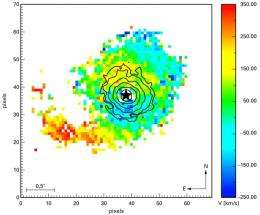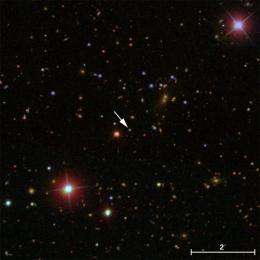Cosmic weight watching reveals black hole-galaxy history

(PhysOrg.com) -- Using state-of-the-art technology and sophisticated data analysis tools, a team of astronomers from the Max Planck Institute for Astronomy has developed a new and powerful technique to directly determine the mass of an active galaxy at a distance of nearly 9 billion light-years from Earth. This pioneering method promises a new approach for studying the co-evolution of galaxies and their central black holes. First results indicate that for galaxies, the best part of cosmic history was not a time of sweeping changes.
One of the most intriguing developments in astronomy over the last few decades is the realization that not only do most galaxies contain central black holes of gigantic size, but also that the mass of these central black holes are directly related to the mass of their host galaxies. This correlation is predicted by the current standard model of galaxy evolution, the so-called hierarchical model, as astronomers from the Max Planck Institute for Astronomy have recently shown.
When astronomers look out to greater and greater distances, they look further and further into the past. Investigating this black hole-galaxy mass correlation at different distances, and thus at different times in cosmic history, allows astronomers to study galaxy and black hole evolution in action.
For galaxies further away than 5 billion light-years (corresponding to a redshift of z > 0.5), such studies face considerable difficulties. The typical objects of study are so-called active galaxies, and there are well-established methods to estimate the mass of such a galaxy's central black hole. It is the galaxy's mass itself that is the challenge: At such distances, standard methods of estimating a galaxy's mass become exceedingly uncertain or fail altogether.
Now, a team of astronomers from the Max Planck Institute for Astronomy, led by Dr. Katherine Inskip, has, for the first time, succeeded in directly "weighing" both a galaxy and its central black hole at such a great distance using a sophisticated and novel method. The galaxy, known to astronomers by the number J090543.56+043347.3 (which encodes the galaxy's position in the sky) has a distance of 8.8 billion light-years from Earth (redshift z = 1.3).

The astronomers succeeded in measuring directly the so-called dynamical mass of this active galaxy. The key idea is the following: A galaxy's stars and gas clouds orbit the galactic centre; for instance, our Sun orbits the centre of the Milky Way galaxy once every 250 million years. The stars' different orbital speeds are a direct function of the galaxy's mass distribution. Determine orbital speeds and you can determine the galaxy's total mass.
This is much easier said than done. In order to secure their measurement, the cosmic weightwatchers had to pull out all the stops of observational astronomy before finally obtaining a reliable value for the dynamical mass of J090543.56+043347.3. Combining this result with the mass value of the galaxy's central black hole, which the researchers measured from the same dataset, the result is the same that would be expected for a present-day galaxy. Apparently, nothing major has changed between now and then: At least out to this distance, 9 billion years into the past, the correlation between galaxies and their black holes appears to be the same as for their modern-day counterparts.
Inskip and her colleagues are already hard at work to expand their novel kind of analysis to a larger set of 15 further galaxies. If this confirms their conclusions from J090543.56+043347.3, that would indicate that, over the past 9 billion years – for more than half of the age of our Universe! – most galaxies have lived comparatively boring lives, subject to only very limited and slow change.
More information: K. J. Inskip, et al., Resolving the Dynamical Mass of a z ~ 1.3 Quasi-stellar Object Host Galaxy Using SINFONI and Laser Guide Star Assisted Adaptive Optics, Astrophysical Journal, Volume 739, Issue 2, article id. 90 (2011)
Provided by Max-Planck-Gesellschaft













.jpg)







